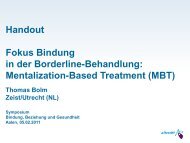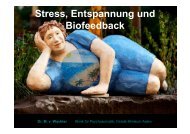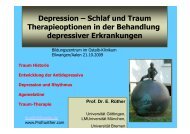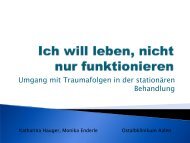Resource
Resource
Resource
Create successful ePaper yourself
Turn your PDF publications into a flip-book with our unique Google optimized e-Paper software.
Recognizing and Developing<br />
<strong>Resource</strong>s in Psychotherapy<br />
Psychosomatic Medicine and Psychotherapy<br />
The Treatment of Somatized Mental Disorders<br />
Conference at Tongji Hospital April 16-17, 2010<br />
Tongji University Medical School, Shanghai, PR China<br />
Sponsored by the DFG (Deutsche Forschungsgemeinschaft)<br />
Dr. med. Askan Hendrischke Psychosomatic Clinic, Ostalb-Hospital Aalen<br />
Dr. med. Martin von Wachter<br />
www.psychosomatik-aalen.de
Activating <strong>Resource</strong>s<br />
<strong>Resource</strong>s<br />
More <strong>Resource</strong>s = Loss Hurts Less<br />
Illness<br />
www.psychosomatik-aalen.de
Memories<br />
<strong>Resource</strong>s Significant Other,<br />
Family Members<br />
Work<br />
Free Time<br />
Competency<br />
and Skills<br />
Attitudes<br />
Mental Approach<br />
Visions, Goals, Ideas<br />
Health<br />
Appearance<br />
Hobbys and Interests<br />
Economic Stability<br />
Friends<br />
and Neighbors<br />
Relationship<br />
to the Therapist<br />
www.psychosomatik-aalen.de<br />
Photocase:misterQM
<strong>Resource</strong>s<br />
Individual, Internal <strong>Resource</strong>s<br />
Skills, Visions, Goals, Interests, Attitudes, Appearance, Knowledge,<br />
Memories<br />
External <strong>Resource</strong>s<br />
Work, Health, Economic Stability, Hobbys<br />
Interpersonal <strong>Resource</strong>s<br />
Significant Other, Family Members, Friends, Therapist<br />
www.psychosomatik-aalen.de
Activating <strong>Resource</strong>s<br />
Each opportunity to which a person has<br />
access which satisfies their basic needs<br />
(Attachment/Autonomy, Self Esteem, Control, Pleasure,<br />
Competence)<br />
To the question, how can the problems best be<br />
solved, the resources are likely more important than<br />
the problems themselves<br />
(Indication and Treatment Grawe 1999)<br />
www.psychosomatik-aalen.de
Patient<br />
Interactions<br />
Activation of strengths, skills and positive goals<br />
Grawe 1999, 2004, Orlinsky 1994<br />
Security with therapist?<br />
Doctor-patient relationship<br />
Positive experiences<br />
Regarding basic needs<br />
www.psychosomatik-aalen.de
Grawe: Therapy Research<br />
Problem and resource activation work together<br />
At the start, resources are important due to large<br />
amounts of shame and a low level of motivation to<br />
change<br />
www.psychosomatik-aalen.de
Neurobiology<br />
• The goal of therapy is to establish new neuronal paths<br />
and patterns<br />
• The transfer-capacity between synapses is raised<br />
through the release of dopamine<br />
• The release of dopamine is typically the response to<br />
pleasurable input through things that satisfy the need for<br />
pleasure.<br />
• Overcoming problems, thus creating new patterns within<br />
the context of activating resources, should result in<br />
being in a motivated state<br />
• Without the activation of the Dopamine System, longterm<br />
learning will not take place<br />
www.psychosomatik-aalen.de
Attitude or Technique?<br />
The therapist should…<br />
• Recognize and name the positive in others -> The patient<br />
sees that his strengths are recognized-> Self-worth<br />
• Have trust in the patient‘s potential to develop<br />
• Quirks of the patient should be seen as a resource rather<br />
than a problem for the therapy (Grawe)<br />
• Provide experiences for the patients about healthy,<br />
positive parts of their personality, about competence and<br />
experiences that support selfworth as well as provide<br />
helpful support systems<br />
www.psychosomatik-aalen.de
Complementary Joining<br />
Dependent<br />
Distrusting<br />
Alone<br />
Narcisstic<br />
Emotional<br />
Rational<br />
• Directive<br />
• Transparent<br />
• Allow the Patient to Decide<br />
• Allow the Patient to be seen<br />
in a positive light<br />
• Experience-Orientiered<br />
• Make Conscious, Aware<br />
Grawe 1998<br />
www.psychosomatik-aalen.de
<strong>Resource</strong>s in all „Schools“<br />
Cognitive Behavior Therapy<br />
Hypnotherapy – Erickson<br />
Salutogenese: SOC, Antonowsky<br />
Solution Focussed Brief Therapy - de Shazer<br />
Systemic Therapy<br />
Grawe: Deciding Factors<br />
OPD 2<br />
Positive Psychology – Seligman<br />
www.psychosomatik-aalen.de
In Conversation<br />
Let the patient describe what he does well, what interests<br />
him, areas in which he is the expert<br />
Give him opportunities to present his strengths<br />
Questions: How did you manage to do that?<br />
Keep the patient in the area of resources:<br />
How did you feel? How could others realize how you felt?<br />
www.psychosomatik-aalen.de
Recognizing <strong>Resource</strong>s<br />
Which Goals and Skills were developed for satisfying<br />
Basic Needs?<br />
What would you like to keep the same in your life?<br />
What can stay the same?<br />
What do you like about yourself?<br />
The therapist can use these answers<br />
later in the therapeutic process<br />
www.psychosomatik-aalen.de
Obstacles that stand in the way<br />
Therapist: Pathological Categories, Psychological<br />
Models<br />
Patient: actual Problems e.g. Depression<br />
Therapist must steer as needed<br />
www.psychosomatik-aalen.de
Side Effects<br />
Patient doesn‘t feel his Problems are<br />
recognized or seen<br />
Unrealistic Desires activated -> Frustration<br />
Avoidance<br />
Activating <strong>Resource</strong>s is misunderstood as<br />
„Positive Thinking“<br />
www.psychosomatik-aalen.de
Questionaire to Measure the Actual<br />
Realisation of <strong>Resource</strong>s (RES)<br />
Berner Ressourceninventar<br />
Troesken und Grawe 2002<br />
http://www.troesken.eu<br />
Scales<br />
Well-Being<br />
Self-worth<br />
Positive Self-Image<br />
Developing Senses<br />
Social Supports<br />
Current Relationships<br />
Stress Management<br />
Crisis Management<br />
Characteristics of Early Care Givers<br />
www.psychosomatik-aalen.de
Develop <strong>Resource</strong>s<br />
Strengthen Current <strong>Resource</strong>s<br />
Activate Unused and Prior <strong>Resource</strong>s<br />
Create New <strong>Resource</strong>s<br />
www.psychosomatik-aalen.de
Interventions<br />
Ressourcen ABC<br />
Diary of Joy or Happiness<br />
Feedback Group<br />
Ressourcium-Cards (M. Huber)<br />
<strong>Resource</strong> Oriented Life Story<br />
www.psychosomatik-aalen.de
<strong>Resource</strong> Genogram<br />
Who is someone that who especially liked as a child?<br />
What characteristics of your mother or father do you especially<br />
appreciate?<br />
What positive things have you learned from your father/mother?<br />
Which tools for Life have you been given by your family?<br />
Which resources did your relatives use?<br />
Are there positive stories or legends that exist about your family?<br />
Does your family have a family treasure or heirloom?<br />
www.psychosomatik-aalen.de
<strong>Resource</strong>- Genogram<br />
father,<br />
patience,humor<br />
traveling with husband<br />
proud of son<br />
grandfather,<br />
magic tricks<br />
aunt,<br />
mentor/hero,<br />
explained things<br />
Pat.<br />
sunshine<br />
mom, hard working +<br />
quiettime<br />
patient, perseverence,<br />
make the best of, responsible,<br />
dependable,<br />
grandma, smart,<br />
taught her to sing<br />
www.psychosomatik-aalen.de
The Apartment<br />
Floorplan<br />
Hubschmid 1983<br />
www.psychosomatik-aalen.de
Exceptions<br />
Ask about times or exceptions<br />
when things went well and how was it different?<br />
When/in what way did it work out?<br />
How often did the problem not appear?<br />
What was different at that time?<br />
photocase_zettberlin.jpg<br />
www.psychosomatik-aalen.de
Miracle Question<br />
When the problem would suddenly be gone over night…<br />
…What would be the first thing that you would do?<br />
The second, the third ……?<br />
Who would be the first to notice and how?<br />
What would the people around you do differently?<br />
How would they react?<br />
Steve de Shazer 1987<br />
www.psychosomatik-aalen.de
People you admire, mentors<br />
Do you know someone<br />
who has the right resources?<br />
How does he behave?<br />
What do they do differently from others?<br />
Have you acted like your mentor before? What did<br />
others notice?<br />
Experience resources immediately/directly<br />
www.psychosomatik-aalen.de
Reframing<br />
Upside/ advantages of/to the problem<br />
touchy alert<br />
distrusting careful<br />
stuck perseverance<br />
confused perception of many possibilities<br />
Discover what can be „good“ in the situation<br />
Captain - the piccture<br />
hangs crooked !<br />
www.psychosomatik-aalen.de
Absorption - Technique<br />
Which 3 skills do you need in order to handle this<br />
problem better?<br />
Name a situation where you already possessed these<br />
skills<br />
Think about that situation. Can you feel that you had<br />
these skills somewhere in your body?<br />
www.psychosomatik-aalen.de
C. Lechner: Alltagsmenschen<br />
Foto: V. Gräschus<br />
Thanks for your Attention!<br />
Materials, further information and literature at<br />
www.psychosomatik-aalen.de/ressourcen<br />
www.psychosomatik-aalen.de











